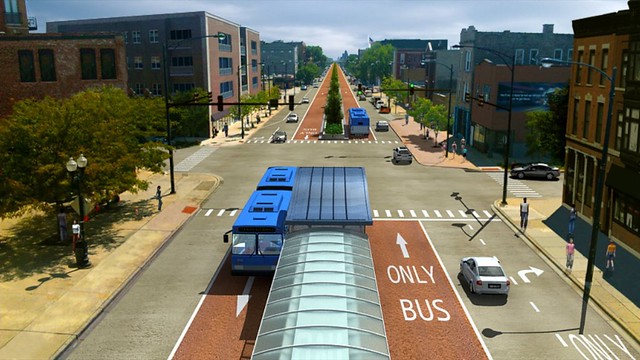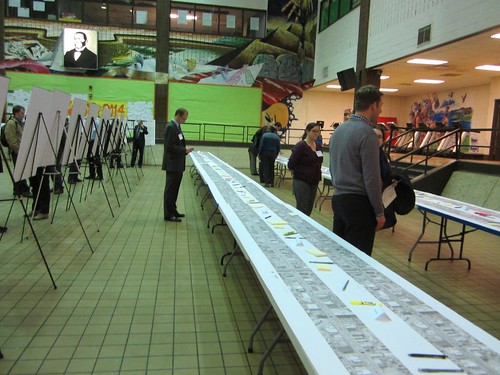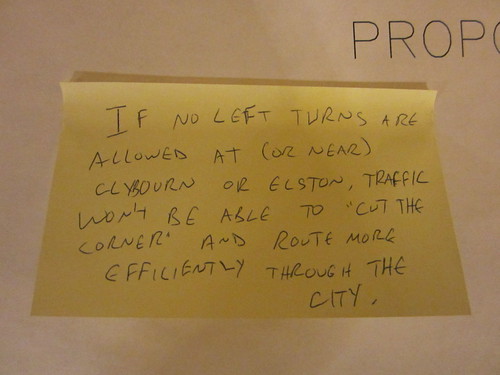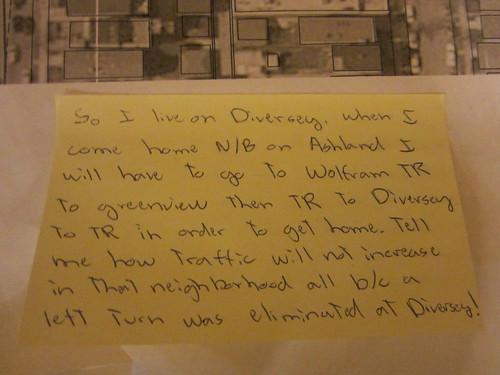One of the most controversial aspects of the CTA’s plan to create bus rapid transit on Ashland Avenue is the prohibition of most left turns from Ashland. Since the buses will operate in dedicated lanes next to the median, any left turns by vehicles from the mixed-traffic lanes will require that the buses get a red light while the turning vehicles get a green arrow. Watering down the BRT route with too many left turns would significantly slow down the buses.
Fortunately, the left-turn ban will be a relatively simple adjustment for nearby residents, people patronizing businesses on Ashland, and delivery drivers. Since Chicago is blessed with a nearly uninterrupted street grid, with a little prior route planning it will be easy for motorists to choose routes that don’t require making a left off of Ashland. Delivery companies like UPS already plan their routes to avoid lefts in order to save on time and gas.
Furthermore, as Active Transportation Alliance director Ron Burke recently told the Sun-Times, barring most left turns will help reduce traffic injuries and fatalities. Ashland has several times the number of pedestrian, bike, and car crashes per mile as the average Chicago surface street. And while collisions involving left turns account for 11.7 percent of all reported Chicago crashes, they make up 15 percent of the collisions on Ashland, with left-turn crashes taking place every three or four days on the street, Burke said.
Still, residents’ legitimate concerns about the planned changes to Ashland need to be addressed. At the CTA's open houses about BRT on the South Side and the North Side this week, many attendees stuck Post-it notes on a giant “roll plot” map of Ashland to provide input, and many of the notes from residents involved concerns about how the left-turn ban would affect commuting and deliveries. Let’s take a look at a few of these comments to see how proper routing can resolve these issues.
View Illinois Medical District in a larger map
Current route is in red, post-BRT route is in green.
It's worth noting that the Illinois Medical District, where these hospitals are located, is an official supporter of the BRT plan, because they understand that buses that are 50 percent more reliable and nearly twice as fast as the current service will make it easier for staff, students and patients to access the facilities. New developments are planned for many parcels of land, including existing parking lots, within the district, so it will be even more important to provide an efficient, attractive alternative to driving there. Once BRT is implemented, northbound drivers should simply approach the district from Damen, four blocks west of Ashland, instead of Ashland, and then head east on Roosevelt or Taylor to access the hospitals.
View Elston and Clybourn in a larger map
Current routes are in red and orange; post-BRT routes are in green and blue.
In this case, northbound motorists should take Halsted, a mile east of Ashland, as an alternative. Clybourn can be accessed directly from Halsted. To get to Elston from Halsted, drivers can head west on North and then go northwest on Elston. Either way, they'll be able to take more advantage of the shortcuts provided by these diagonal streets by getting on them earlier.
View Diversey in a larger map
Current route in red; post-BRT route on Post-It in orange; proper post-BRT routes in green, blue and purple.
Rather than doing the jug-handle maneuver on side streets the commenter describes, he or she could head north on Halsted and then travel west on Diversey, or approach from Damen or Clybourn and then turn east on Diversey. As you can see from these three examples, there are plenty of ways that destinations on or near Ashland can be accessed without making left turns from the street. Fears that the left-turn ban will kill businesses by making it difficult for customers to access them, play havoc with deliveries, or send excessive traffic barreling down residential streets, while understandable, are not realistic.








